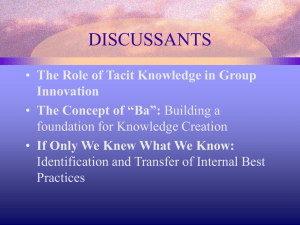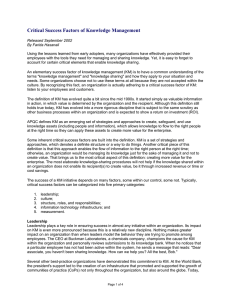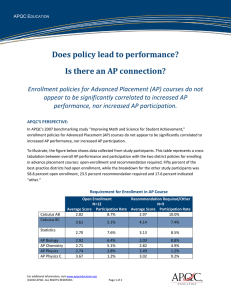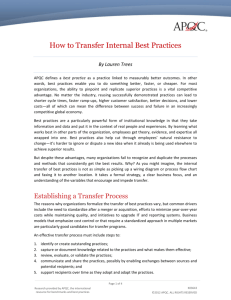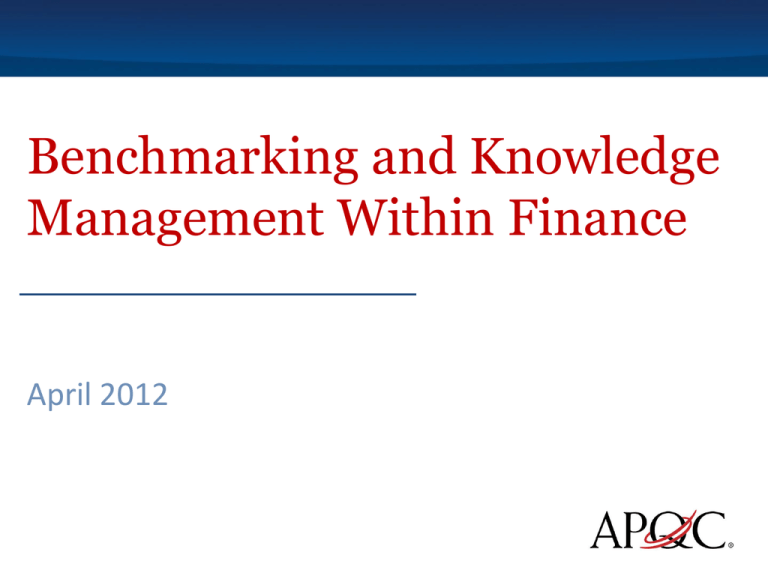
Benchmarking and Knowledge
Management Within Finance
April 2012
What we’ll cover today
Welcome/Introductions
Who we are
Getting Started
Defining your process
Selecting your measures
Execute the benchmarking project
Interpret the results and apply experience
Discover the best practices
Knowledge Management/Sharing Tools
©2012 APQC. ALL RIGHTS RESERVED.
2
Welcome and Introductions
…this is where you get to participate.
©2012 APQC. ALL RIGHTS RESERVED.
3
Introduce Yourself
Name
Company
Role/Job Title
Experience with benchmarking or best
practice research?
What do you hope to learn today? Why are
you here?
©2012 APQC. ALL RIGHTS RESERVED.
4
Your APQC Team
Ron Webb
Executive Director, Research
Services
APQC
713-685-4634
rwebb@apqc.org
@rwebb_apqc
©2012 APQC. ALL RIGHTS RESERVED.
Mary Driscoll
Senior Research
Fellow
APQC
713-685-7255
mdriscoll@apqc.org
5
Who We are…
…and why you should care.
©2012 APQC. ALL RIGHTS RESERVED.
6
Who we are
APQC is a member-based, 501(c)3 nonprofit
specializing in benchmarking, knowledge
management, measurement, and process
improvement.
Our mission is to work with organizations
around the world to improve productivity and
quality by:
discovering effective methods of improvement,
broadly disseminating findings, and
connecting individuals with one another and with
the knowledge they need to improve.
©2012 APQC. ALL RIGHTS RESERVED.
7
APQC’s core competencies
Frameworks and maturity models
Benchmarking and best practices
Knowledge Management
Process improvement and measurement
Metrics and measures
©2012 APQC. ALL RIGHTS RESERVED.
8
APQC highlights
1977
• APQC opens its doors as APC
1985
• Co-founded the Malcolm Baldrige National Quality Award
1991
• International Benchmarking Clearinghouse made it’s debut
1992
• APQC develops business taxonomy with The Process Classification
FrameworkSM (PCF)
1995
• Partners with Arthur Anderson to sponsor the 1st Knowledge
Imperative Symposium, now known as the KM Conference
1996
• Chairman Grayson again set course to improve performance and
productivity with a major education initiative
2001
• Recipients of the 100 Companies That Matter in Knowledge
Management, by KMWorld magazine
2010
• Only 10-year recipient of the 100 Companies That Matter in
Knowledge Management, by KMWorld magazine
©2012 APQC. ALL RIGHTS RESERVED.
9
Getting Started…
…some key definitions.
©2012 APQC. ALL RIGHTS RESERVED.
10
Discussion Point
Who would offer up a definition for:
A benchmark
Benchmarking
A best practice or practice
Knowledge Management
©2012 APQC. ALL RIGHTS RESERVED.
11
Where Did the Word “Benchmark”
Come From?
First used by cobblers to measure people's
feet for shoes.
They would place someone's foot on a "bench"
and mark it out to make the pattern for the
shoes.
You can see how this term has evolved to
be used in business today.
Source: Wikipedia
©2012 APQC. ALL RIGHTS RESERVED.
12
Benchmarks and Benchmarking
Benchmark
Benchmarking
Standards and/or
Best practices
and/or what works
measures
How much to
improve
©2012 APQC. ALL RIGHTS RESERVED.
How to improve
13
Informal Definition
Benchmarking is the practice of being
humble enough to admit that others are
better at something and being wise enough
to learn how to match, and even surpass,
them at it.
©2012 APQC. ALL RIGHTS RESERVED.
14
Best Practice/Practice
Methods and techniques that
have consistently shown results
superior than those achieved with
other means
Used as benchmarks to strive for,
however:
There is no practice that is best for
everyone or in every situation
No best practice remains best for
very long as people keep on finding
better ways of doing things
©2012 APQC. ALL RIGHTS RESERVED.
15
Typical Benchmarking Life Cycle
Metrics
Practices
“I want to see how I compare.”
“I don’t believe it, let’s
compare again.”
Wash, rinse, repeat. (for the
really stubborn)
“OK, I give up, how are they
able to perform that
way!?!?!?!”
©2012 APQC. ALL RIGHTS RESERVED.
16
Knowledge Management
Knowledge management (KM)
connects employees to each
other, to knowledge assets,
and to those with useful
experience.
These actions accelerate the
rate of learning and cut down
the risks of not knowing and
repeating mistakes.
These actions solve business
problems!
©2012 APQC. ALL RIGHTS RESERVED.
17
More on this KM Thing…
…what is it, really?
(psst, you’ve been doing this for years)
©2012 APQC. ALL RIGHTS RESERVED.
18
Knowledge Management Components
People
Processes
Content
Technology
Knowledge is “STICKY” . . .
The Knowledge Flow Process ©
Without a systematic process and organizational environment,
it WILL NOT MOVE!
©2012 APQC. ALL RIGHTS RESERVED.
19
Successful KM Uses a Blend of KM
Approaches
©2012 APQC. ALL RIGHTS RESERVED.
20
Some Examples of KM in F&A
Communities of Practice
Focused on key issues or processes
After-Action-Reviews
Focused on significant events
Closing the books
Merger/Acquisition
Site/Location consolidation
See, you have been doing this!
Expertise Location
Very specific situations
Closing the books (monthly/annually)
Reporting
Order-to-Cash
Sales & Operations Planning/Demand Forecasting
Local/Regional tax experts
Specific regulations
Legal counsel
Content Management/Process Management
Documenting and automation of “back office” duties
AP, AR, expense report submissions, etc.
Use of ERP systems for standard work and data capture
©2012 APQC. ALL RIGHTS RESERVED.
21
Discussion Point
What are some examples from F&A that might
be knowledge management or knowledge
sharing activities?
Content management
Communities of practice
Facilitated best practice transfer
Portals/Repositories
Expertise location
Project reviews/after-action reviews
Others
©2012 APQC. ALL RIGHTS RESERVED.
22
Let’s Get Started…
©2012 APQC. ALL RIGHTS RESERVED.
23
Who Do You Trust?
If you had a business problem, who would
you trust to help solve it?
A subject matter expert?
The “group think” or “conventional
wisdom”?
A group of your industry peers?
Your boss?
A consultant?
A college professor?
This guy on the right?
©2012 APQC. ALL RIGHTS RESERVED.
24
This Isn’t A Commercial
for APQC
If it sounds like it, it’s because:
This is the approach our members asked us to
develop to help them benchmark their key
organizational processes.
Fine-tuned by our members and network of
advisors over many years.
For benchmarking and best practices, our
members have done a lot of work to make
your life easier.
Go make new mistakes!
©2012 APQC. ALL RIGHTS RESERVED.
25
Defining Your Process…
…how you get work done.
©2012 APQC. ALL RIGHTS RESERVED.
26
Process – The Big Picture
People
Technology
Process
Process is how we do work!
Processes are enabled through people and
technology
We improve performance by improving
processes
©2012 APQC. ALL RIGHTS RESERVED.
27
Discussion Point
Who has documented any, most, or all of
their key finance or accounting processes?
Who uses an external process or business
frameworks?
©2012 APQC. ALL RIGHTS RESERVED.
28
Process Classification Framework
APQC’s Process Classification FrameworkSM (PCF) is a
taxonomy of business processes that allows organizations
to objectively track and compare their performance
internally and externally with organizations from any
industry.
Built and regularly updated through collaboration with
experts, practitioners, consultants, and academicians.
Most downloaded document.
Developed in the early 1990s
Used for many purposes
Benchmarking
Standardization and measurement
Governance and accountability
Managing key functions and entire
organizations
©2012 APQC. ALL RIGHTS RESERVED.
29
Easy Access and Use
©2012 APQC. ALL RIGHTS RESERVED.
30
PCF Details
©2012 APQC. ALL RIGHTS RESERVED.
31
APER Example
What is the
value in this
type of
inventory?
©2012 APQC. ALL RIGHTS RESERVED.
32
Value Really Shows When You Make It
Yours
REALLY VALUABLE!
©2012 APQC. ALL RIGHTS RESERVED.
33
Key Takeaways!
Know your process
Use a process framework.
Collaborate
Bring the key staff together to agree on a standardized
view of how work is done.
Adapt it
Agree on the activities that are being examined.
Make it your own and use it to govern, measure, and
improve.
This approach will work for any process area.
AP is just an example.
©2012 APQC. ALL RIGHTS RESERVED.
34
Selecting Measures…
…I don’t have a cool tag line for this slide.
©2012 APQC. ALL RIGHTS RESERVED.
35
Key Performance Indicators and
Metrics
Key Performance Indicators (KPI)
Explicitly tied to operational objectives and
strategy.
Central to measuring progress toward the
achievement of business goals.
Categories of Metrics
Cost Effectiveness
Process Efficiency
Staff Productivity
Cycle time
©2012 APQC. ALL RIGHTS RESERVED.
36
Cost Effectiveness
Provides information concerning how well
operating cost are managed. Key performance
indicators usually include:
Cost per unit (e.g., invoice, check, and square foot)
Cost as a percentage of revenue
Cost as a percentage of total budget (e.g.,
accounts payable cost as a percentage of total F&A
cost)
Actual cost versus budgeted cost
Supporting indicators usually include cost
components as a percentage of total.
©2012 APQC. ALL RIGHTS RESERVED.
37
Staff Productivity
Provides insights into how much output each
full-time equivalent (FTE) employee has
produced. Key performance indicators usually
include:
Units of output (e.g., invoices and purchase
orders) per FTE
Workload (e.g., customers and general ledger
accounts) per FTE
Supporting indicators usually focus on factors
that influence staff productivity such as hours
of training per FTE and employee tenure.
©2012 APQC. ALL RIGHTS RESERVED.
38
Process Efficiency
Provides insights into how well procedures and
systems support operations. Key performance
indicators usually include:
Error rate (i.e., rework rate)
Forecast accuracy rate (e.g., actual vs. forecast and
non-cost measures)
Supporting indicators usually focus on factors
that influence process efficiency such as
system downtime rate and the degree of
process automation.
©2012 APQC. ALL RIGHTS RESERVED.
39
Cycle Time
Indicates the duration to complete a task.
These Key performance indicators are
measured in units of time (e.g., hours, days,
and months) and usually include:
Processing time
Time to resolve customer inquiry
Supporting indicators usually focus on
factors that influence cycle time such as the
frequency of system breakdowns.
©2012 APQC. ALL RIGHTS RESERVED.
40
Subjective Ratings
Metrics
With subjective ratings, we lack a reliable reference
point or benchmark.
How tall is President Obama? (Circle one)
1
Very Short
2
3
4
5
6
7
Very Tall
Subjective ratings invite potential bias, and solicit
perception rather than reality.
How great of a presenter am I?
1
2
Most Excellent
3
4
5
6
7
Supreme
How would you rate your average cycle time performance for your
core job responsibility?
1
Very Slow
©2012 APQC. ALL RIGHTS RESERVED.
2
3
4
41
5
6
7
Very Fast
Discussion Point
Who’s familiar with working with
normalized data?
Benefits?
What are some of the key variables used to
normalize data?
©2012 APQC. ALL RIGHTS RESERVED.
42
KPI List for AP
Cycle time in days to approve and schedule T&E
reimbursements
Percentage of disbursements that are first time
error free
Percentage of discounts available that are taken
Percentage of invoice line items paid on time
Percentage of invoice line items received
electronically
Percentage of invoice line items that are matched
the first time
Total cost to perform the process "process accounts
payable" per $1,000 revenue
©2012 APQC. ALL RIGHTS RESERVED.
43
Examples of Definitions
©2012 APQC. ALL RIGHTS RESERVED.
44
Key Takeaways
Be clear on your measures and metrics.
Use definitions.
Make sure your measures are tied to
activities and the outcomes you want to
know.
You can’t compare what you don’t ask.
There are tradeoffs with every data point
you will collect.
Weigh the tradeoff vs. not acting.
Apply judgment.
©2012 APQC. ALL RIGHTS RESERVED.
45
Executing a Benchmarking
Project…
…focus on the basics, you can “complex it up” later.
©2012 APQC. ALL RIGHTS RESERVED.
46
Decision Time and
Trade-Offs
Do it yourself.
Customize project to your specifications.
You can ask what you want to who you want.
Labor intensive. You have a day job.
Not a core competency.
Survey design, data validation, contacting/screening, etc.
Confidentiality.
Use available resources.
You have to use what is there.
Faster turnaround.
Addresses core competency issues.
Someone else does all the leg work. You focus on
value-added activities.
©2012 APQC. ALL RIGHTS RESERVED.
47
If You Want to Do-It-Yourself
Still use APQC resources. It is our Mission!
Standard Processes/Activities (PCF)
Standard Definitions
Measures/Metrics
But, you’ll need to address the following
issues…
©2012 APQC. ALL RIGHTS RESERVED.
48
Benchmarking Success Components
©2012 APQC. ALL RIGHTS RESERVED.
49
Benchmarking Methodology
©2012 APQC. ALL RIGHTS RESERVED.
50
Planning Phase
©2012 APQC. ALL RIGHTS RESERVED.
51
Collecting Phase
©2012 APQC. ALL RIGHTS RESERVED.
52
Analyzing Phase
©2012 APQC. ALL RIGHTS RESERVED.
53
Adapting Phase
©2012 APQC. ALL RIGHTS RESERVED.
54
APQC’s 24/7 Metric Benchmarking
Process
©2012 APQC. ALL RIGHTS RESERVED.
55
Keep an open mind about peers
You want to be better than your industry
peers!
©2012 APQC. ALL RIGHTS RESERVED.
56
Discussion Point
Who would you choose as a benchmarking
peer?
Why?
What criteria make a good benchmarking
peer?
©2012 APQC. ALL RIGHTS RESERVED.
57
When to choose different peers?
Competitor? Same industry?
Industry leader?
Similar size?
Transactional peer?
Executes similar number of Invoices per year?
Similar “buy” volume?
Similar business model?
Number of employees?
Annual sales revenue?
Complexity? Global vs. Local vs. Regional?
Shared Service vs. Decentralized?
Located near you?
Part of your supply chain or value chain?
Suppliers? Partners?
©2012 APQC. ALL RIGHTS RESERVED.
58
Interpreting and Using Data and
Information
…context is critical to ensure appropriate action
©2012 APQC. ALL RIGHTS RESERVED.
59
Data Reporting
Synthesizes analysis
into concise and
relevant findings.
Display findings using
graphs, tables, and
narration.
Measurement
reporting should be
clear, concise, and
most of all visual.
©2012 APQC. ALL RIGHTS RESERVED.
60
I Can Save You a Lot of Grief Now!
“The Number” doesn’t
exist.
The data isn’t the story;
the impact on your
organization is the story.
You have to give data
context for it to be useful.
The results of metric
benchmarking combined
with best practice
information and your (and
your teams’) experience is
the real power of
benchmarking.
©2012 APQC. ALL RIGHTS RESERVED.
61
Benchmarking Peer Groupings
©2012 APQC. ALL RIGHTS RESERVED.
62
Picking Your “Number”
©2012 APQC. ALL RIGHTS RESERVED.
63
Applying Judgment and Experience
©2012 APQC. ALL RIGHTS RESERVED.
64
Discussion Point
What are some of the most creative
displays of data and information you’ve
seen?
What reports have you found most useful?
How would you go about determining your
“gut” factor for theoretical cost savings?
©2012 APQC. ALL RIGHTS RESERVED.
65
Key Takeaways!
Pick your approach and dedicate the time
required of the task.
Be open to different peer groups.
Sometime a “process peer” is a better choice
than an industry peer.
Give the information context and a gut
check.
©2012 APQC. ALL RIGHTS RESERVED.
66
Discover Best Practices…
…the “how” is just as important as the “how much”.
©2012 APQC. ALL RIGHTS RESERVED.
67
Qualitative Information
Tells the “how” story
Focuses on the critical success factors
What allows companies to perform in a stellar
manner?
People?
Process?
Technology?
Culture/Leadership?
How companies close the
gap in performance
©2012 APQC. ALL RIGHTS RESERVED.
68
Financial Management:
The Quest for Excellence
Mary C. Driscoll
©2012 APQC. ALL RIGHTS RESERVED.
69
CFOs are Investing in
Financial Process Improvement
“We see more robust analytics and
decision support being provided
internally, which is contributing to the
increased size and scope of consulting
engagements focused on finance and
accounting processes and
technology.”
- Kennedy Information, LLC
©2012 APQC. ALL RIGHTS RESERVED.
70
Currently pursuing a major
process improvement in FM?
19%
Yes
No
81%
Source: APQC Research, March 2012:
Finance Improvement Programs Now Aim at Both Value and Cost
©2012 APQC. ALL RIGHTS RESERVED.
71
Top Priority?
1%
Both efficiency and effectiveness
11%
Efficiency (improve finance
cost/productivity profile, accelerate
cycle speed, reduce error rates)
16%
Effectiveness (deliver more effective
analytical support to the business)
Don’t know
72%
Source: APQC Research, March 2012:
Finance Improvement Programs Now Aim at Both Value and Cost
©2012 APQC. ALL RIGHTS RESERVED.
72
Making Progress?
Where is your finance organization today on the road to
becoming a more highly valued partner to the business?
Where's the road?
12%
4%
Recently started and hopeful
22%
Making some progress but facing
obstacles
30%
Gaining traction and overcoming some
obstacles
32%
©2012 APQC. ALL RIGHTS RESERVED.
Rolling along with confidence and
learning more about this journey
73
Strategic Imperatives Behind
the Investment Surge
Sustainable, profitable growth is elusive
Products and services must be customized
allocate the right resources at the right times
deliver profitability analyses and scenario modeling
Growing regulatory scrutiny
improve accuracy, transparency, accountability, and auditability
©2012 APQC. ALL RIGHTS RESERVED.
74
Finance Improvement Imperatives
Better access to reliable operating data to
speed and improve planning/forecasting
Insightful—and curious!—decision-support
Reduce risk of accounting/reporting errors
Pay for change with more cost-efficiency
Put the right talent with the right tools in
well-defined roles
Deploy new service delivery models
Deploy process owners to drive
change
©2012 APQC. ALL RIGHTS RESERVED.
75
Hasn’t Finance Already Been
“Re-engineered” Like Crazy?
A look at APQC metrics reveals the truth
©2012 APQC. ALL RIGHTS RESERVED.
76
Total Cost of Finance as a Percentage
of Revenue – All Participants
2.5%
n=421
2.2%
2.0%
1.5%
1.2%
1.0%
0.6%
0.5%
0.0%
Bottom Performer
Median
Top Performer
Source: APQC Open Standards Benchmarking
©2012 APQC. ALL RIGHTS RESERVED.
77
This alarming situation is unending!
©2012 APQC. ALL RIGHTS RESERVED.
78
Cycle Time in Days to Complete
the Annual Budget Cycle
100
90
90
80
60
60
47.5
40
30
29.5
20
0
Bottom Performers
Median
All Participants
N=416
Top Performers
Durable Goods
N=16
Source: APQC Open Standards Benchmarking
©2012 APQC. ALL RIGHTS RESERVED.
79
Cycle Time in Days to Complete
the Financial Forecast
20
17.25
15
10
8
8
5
4
4
2.5
0
Bottom Performers
Median
All Participants
N=403
Top Performers
Durable Goods
N=16
Source: APQC Open Standards Benchmarking
©2012 APQC. ALL RIGHTS RESERVED.
80
Cycle Time in Days between Completion
of Annual Consolidated Financial
Statements and the Release of Earnings
45
40
40
35
30
25
25
20
20
15
13.75
15
10
10
5
0
Bottom Performers
Median
All Participants
N=164
Top Performers
Revenue > 5 Billion
N=50
Source: APQC Open Standards Benchmarking
©2012 APQC. ALL RIGHTS RESERVED.
81
Case Study: General Mills
How corporate strategy drives finance
priorities and metrics
Hybrid service delivery model puts the right
people in the right jobs
Leverage IT to drive efficiencies
P-card for indirect spending
Win-win terms and discount options
©2012 APQC. ALL RIGHTS RESERVED.
82
Virtuous Capital Cycle at General Mills
Strong ROC delivers:
- Expected return to investors (WACC)
- Excess capital to return to equity
investors (return in excess of WACC)
Share
Repurchase
Equity and
Credit
Investors
Improving
ROC
- Earnings
growth
- Efficient use
of capital
Equity and credit investors provide
capital to GMI
Working
Capital
Dividends
CAPEX
Debt Service
M&A
GMI invests in efficient growth of
business (ROC)
©2012 APQC. ALL RIGHTS RESERVED.
83
Ensuring Effective Capital Mgt.
General Mills’ Monthly Working Capital Check-up:
Working capital metrics versus the plan and last year,
Receivables performance,
Payables performance,
Review of business unit current assets and current
liabilities,
Overview of business performance and impact on
inventories,
Quarterly working capital
implications versus targets, and
Discussion of potential actions to
achieve targets.
©2012 APQC. ALL RIGHTS RESERVED.
84
General Mills Mgt. Incentive Metrics
Performance ratings and incentive pay are
tied to shareholder value drivers such as:
Net sales growth
Segment operating profit growth
Diluted earnings per share growth
Return on Capital improvement
©2012 APQC. ALL RIGHTS RESERVED.
85
General Mills Rigorous Tracking of
AR Performance Metrics
4
100%
100%
95%
3
96%
90%
2
92%
85%
1
88%
80%
0
84%
75%
Avg. Days Delinquent
Collection Effectiveness
GMI
50% Quartile
©2012 APQC. ALL RIGHTS RESERVED.
25% Quartile
75% Quartile
86
Percentage Current
General Mills AP Best Practices
Hybrid service delivery model puts the right
people in the right jobs
Leverage IT to drive efficiencies
P-card for indirect spending
Win-win terms and discount options
©2012 APQC. ALL RIGHTS RESERVED.
87
General Mills Annual
Working Capital Benchmarking
©2012 APQC. ALL RIGHTS RESERVED.
88
Survey Results:
Current Trends in FP&A
©2012 APQC. ALL RIGHTS RESERVED.
89
©2012 APQC. ALL RIGHTS RESERVED.
90
Biggest Barriers to Progress
Most frequently cited by 1/3 of respondents:
Lack of:
system integration
common data model
common data repository
operating data for advanced modeling
alternative to spreadsheets as primary tool
©2012 APQC. ALL RIGHTS RESERVED.
91
Biggest Frustrations:
Finance talent is analytical but
not curious
Organizational resistance and
data hoarding
Senior mgt. ignores the model and lets Wall Street
dictate budgets and forecasts
Senior mgt. prefers to make decisions “from the
gut” than allow models to drive choices
Blind focus on short-term goals means models
and analyses get ignored
Planning process not standardized
©2012 APQC. ALL RIGHTS RESERVED.
92
What is FP&A Excellence?
Mastery of
systems,
analytical tools,
and data
management
Can design
reports and selfservice tools
business
managers will use
Strong grasp of
business strategy,
functions,
markets and risks
Deep knowledge
of accounting and
performance
management
©2012 APQC. ALL RIGHTS RESERVED.
Versatile and
polished
communication
skills
Customer service
orientation
FP&A Excellence
93
Insatiable desire
to solve business
puzzles
Key Takeaways!
Turn over more stones to find
new ways to boost productivity
Reducing costs without re-investing in
analytical power may mean relevance
lost
Business managers need faster, better,
more granular insights on rewards/risks
Don’t just purchase fancy planning
software
Develop a strategy for building analytical
capability and influencing your culture
©2012 APQC. ALL RIGHTS RESERVED.
94
Question & Answer
If you think of others, just contact us.
Your APQC Team
Ron Webb
Executive Director, Research
Services
APQC
713-685-4634
rwebb@apqc.org
@rwebb_apqc
©2012 APQC. ALL RIGHTS RESERVED.
Mary Driscoll
Senior Research
Fellow
APQC
713-685-7255
mdriscoll@apqc.org
96

